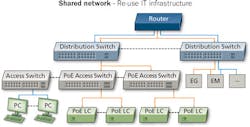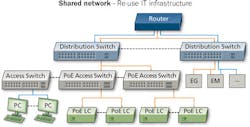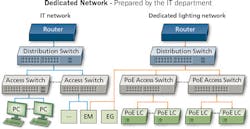Low-voltage lighting an intriguing element of Cisco's Digital Ceiling platform
By Patrick McLaughlin
Market-intelligence firm BSRIA recently reported that its latest study of the structured cabling marketplace shows that the industry’s hot topic is convergence and the impact of digitization. “With the launch of its Digital Ceiling, Cisco has, with its many partners, boosted the level of interest in convergence,” BSRIA noted. “And cabling suppliers and channel players are expecting to see an increase in demand for cabling, and in particular, for higher-specification cabling.”
Cisco launched Digital Ceiling at its Cisco Live event in Berlin, Germany in February.
BSRIA additionally reported that most of the large converged intelligent buildings are new-build or major refurbishments in verticals like retail/shopping centers, high-end offices, universities, hospitals, airports, sports stadiums, government buildings and hotels. Lone Hansen, manager for BSRIA’s IT cable group, commented, “The growth in WAPS [wireless access points] and DBS [distributed building services] is coming from a small base. The main factor that could boost the market is the performance of solutions for the retrofit market.”
Separately, ZK Research principal Zeus Kerravala authored a paper in August titled “A Digital Ceiling is Now a Business Imperative.” Housed on Cisco’s Digital Ceiling website, Kerravala’s paper states, “The evolution to LED lighting creates an opportunity for organizations to bring all of their parallel networks together. New LED lighting systems are now connected to and powered from the corporate data network. The network-powered lighting system can be the centralized hub for a digital ceiling that brings together lighting, building automation and other technologies such as sensors. In fact, the digital ceiling is the easiest, fastest path to a true smart and connected building. The evolution to a digital ceiling will not only make buildings smarter and lower-cost, but can also significantly change the way companies interact with customers and workers.”
Building an ecosystem
Indeed, low-voltage lighting, and particularly lighting that receives power via twisted-pair cabling, has drawn focus to the Digital Ceiling technology platform. Cabling vendors Legrand, Siemon, and Superior Essex are among the partner organizations in the Digital Ceiling ecosystem.
When Siemon announced in March that it had joined the partner community, the company stated, “Unequivocally aligned with Siemon’s ConvergeIT cabling solutions for intelligent buildings, which create a unified infrastructure for converging low-voltage building systems, Cisco’s Digital Ceiling aims to transform buildings to be not only smart, but also connected, highly secure and easy to manage.
“A key part of the Digital Ceiling includes systems and devices that are powered by network switches using Power over Ethernet, including PoE-powered LED lights with sensors that can help lower energy costs by up to 85 percent. Siemon’s ConvergeIT cabling solutions include advanced copper shielded cables and connectivity that provide superior support of PoE-enabled systems.”
Siemon also stated it would work with Smartworld to implement a Digital Ceiling deployment in the Middle East. Smartworld is an Etisalat and Dubai South joint venture company based in Dubai. Bob Allan, global business development manager for intelligent buildings and strategic alliances at Siemon, commented, “Siemon has long been an expert in and advocate for integrated systems over a single unified cabling solution that combines power and control to building devices and lighting to cut cost, save energy and improve overall building control, management and security. From innovative patented crowned jack contact geometry used in our jacks to eliminate the effects of spark gap erosion caused by unmating under PoE load, to shielded cables that are qualified for mechanical reliability and superior heat dissipation in PoE applications, as well as a wide range of components specifically designed to connect lights, sensors and other digital ceiling endpoints, Siemon is well-positioned to help customers like Smartworld quickly and confidently deploy a Cisco Digital Ceiling smart, connected architecture to capitalize on the IoT revolution.”
Lighting capabilities
Allan teamed up with Cisco solutions architect and technical marketing engineering Luis Suau, as well as Philips Lighting U.S. vice president of enterprise sales for commercial/industrial, Keith Moreman, to deliver a web seminar on Digital Ceiling on June 2. Cabling Installation & Maintenance hosted that seminar and it is available for on-demand viewing until December 2. Within it, Cisco’s Suau provided an overview of the platform, including the explanation that LEDs are semiconductors that run on direct-current (DC) power. “With the network being able to provide DC power, there’s a synergy between LED lighting and networks in buildings,” he noted. Furthermore, he explained, if a light has a proverbial “big pipe” of data communication capability-in the form of a high-performance twisted-pair cable-connected to the fixture, that light also can contain sensors to gather data about not just the light, but also about the environment around it. The existence of data-gathering sensors within lights can begin the evolution of data becoming information, information becoming knowledge, and knowledge becoming intelligence-within a building.
During his presentation, Philips’s Moreman stated, “These systems are collecting copious amounts of data. The sensors are constantly gathering information.” Speaking about Philips products in particular, he explained that the system incorporates visible light communication (VLC), which “enables personal control over individual luminaires, groups of luminaires, entire offices, et cetera.”
Among the building-efficiency gains that can be made based on the data/information/knowledge/intelligence are floor-space optimization based on occupancy patterns, and workspace (desk versus meeting-room) decisions.
Moreman also discussed the physical setup of PoE-enabled lighting systems, describing two scenarios. “It can ride on the existing IT infrastructure,” he said, diagramming the path from router to distribution switches. “Off those switches, we run into specific PoE lighting switches, then off to the individual luminaires,” he said. “The switches do not have to be dedicated to lighting exclusively; they also can be used for other applications.”
The other scenario includes a separate network for lighting. “This is the same effective concept, but is a standalone network” entirely devoted to lighting, he said.
Launch Fishers
Legrand and Superior Essex have jointly publicized their participation in a Digital Ceiling deployment at Launch Fishers, a 52,000-square-foot building in Fishers, IN. The facility is designed to serve the unique needs of entrepreneurs working to start and build high-potential enterprises in health, information, life sciences, biotech, consumer products, agri-tech and other technologies.
“To create the kind of environment conducive to entrepreneurial spirt, and to foster innovative teamwork and creative thinking, the Launch Fishers facility created an open office with a collaborative feel to the workspaces,” the companies said. “However, the need for new high-tech amenities such as occupancy sensors, advanced LED lighting and high-speed data communications infrastructure was evident.”
Launch Fishers chief executive officer John Wechsler stated, “It was imperative for us to offer our tenants a work environment that not only offered a high level of efficiency in terms of building systems management, but also promoted the productivity and positive, innovative thinking we associate with our entrepreneurs. We saw lighting as one major area in which we could significantly improve these aspects of the work space and add significant value to our tenant experience.”
Platformatics, an Indiana company that specializes in providing intelligent PoE lighting solutions, was enlisted. That company’s president, Matt Laherty, recalled, “The Launch Fishers facility was a great opportunity for us to showcase the variety of benefits that our PoE lighting solutions can offer to both facilities managers and tenants. For Launch Fishers, we were able to devise a PoE lighting solution that would help them increase their operational efficiency by giving them more control of their lighting network, as well as improve the overall quality of light throughout the work space.”
Superior Essex supplied 10,000 feet of its PowerWise Cat 5e+ cable, and Legrand supplied HDJ series angled patch panels, Category 5e jacks, and two-port surface mount boxes. “Together, this team provided a Digital Ceiling with PoE LED lighting for Launch Fishers, paving the way for a sophisticated converged power, light and data network,” Legrand and Superior Essex said.
In the ZK paper, Kerravala details several benefits of implementing Digital Ceiling technology. Among them is improved worker productivity. He explains, “In an office building, network-powered lighting within the Digital Ceiling can help create a new employee experience and improve productivity because the high color-rendering index allows companies to closely approximate natural light. This improves moods, productivity and health, and it gives workers more energy. Network-enabled lights can be programmed to suit individual needs or task requirements using a laptop, a mobile device or even a tablet mounted to the wall.”
The document cites the Launch Fishers project as well as the project at RBC WaterPark Place III in Toronto as examples of successful Digital Ceiling deployments. (In our July issue we published the article “Enabling IoT capabilities through a single converged IP network,” which detailed the RBC WaterPark Place III project.)
In the conclusion of his paper, Kerravala notes, “In the digital era, the ability to create new experiences that delight customers will be one of the factors that determine marketplace leaders. Also, digital technology can be used to energize the workforce, which will lead to more productive, engaged employees. A Digital Ceiling deployment enables both. Consequently, ZK Research believes that a digital ceiling is now a business imperative and should be at or near the top of every business and IT leader’s priority list.”
Patrick McLaughlin is our chief editor.


